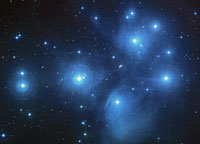 Check out our amazing space and astronomy facts. Learn about all kinds of different space topics that are sure to surprise.
 Star Facts for Kids Star Facts for Kids
Enjoy these fun star facts for kids. Learn how stars are formed, the many various types of stars, how big our star the Sun is relative to other stars, how many stars there are estimated to be in the universe, what colors stars are stars, how old are stars and much more. | | |
As a star is near the end of its life, it begins to change the helium into heavier chemical elements, such carbon and oxygen, and the star will begin to change color, density, mass and size.
After the Sun in our Solar System, the nearest star to Earth is Proxima Centauri. It is about 39.9 trillion km away or 4.2 light years. This means it takes light from this star 4.2 years to reach Earth. Using the newest, fastest space probe propulsion systems would still take a craft about 75,000 years to get there.
Each galaxy contains hundreds of billions of stars and there is estimated to be over 100 billion galaxies in the universe. So the total number of stars in the universe is mind boggling, estimated to be at least 70 sextillion and possibly as high as 300 sextillion, that's 300,000,000,000,000,000,000,000!!!!!
Stars are usually between 1 and 10 billion years old. Some stars may even be close to the age of the observed universe at nearly 13.8 billion years old. Binary stars and multi-star systems are two or more stars that are gravitationally linked, they orbit around each other. Stars form in nebulas, which are large areas of gas and dust. As gravity attracts more and more gas, young stars (called protostars) start to form in thick molecular gases cloud areas of the nebula. Once nuclear fusion has began in the core, a star is sufficiently fuelled to spend the majority of its life as a main sequence star in its most stable form. The most common star, are red dwarfs. They are less than half the size and mass of our Sun, and burn their fuel very slowly so live longer than any other type of star, over 100 billion years. Red dwarfs are cooler than most stars and so shine less, eventually getting dimmer they do not explode. A brown dwarf forms if a star cannot get hot enough to reach nuclear fusion. Its failed to become a proper star but is still not a planet because it does glow dimly. As yellow dwarf stars like our Sun start to run out of hydrogen fuel, the core shrinks, heats and pushes out the rest of the star turning it into a red giant. Red supergiants, such as Betelgeuse in the constellation Orion make our Sun look small, 20x its mass, and 1,000x larger. Red hypergiants such as the largest known star VY Canis Majoris are even bigger, over 1,800x the size of the Sun. When smaller stars such as red dwarfs or red giants use up all their fuel and nuclear fusion slows they start to die, and become small “white dwarf” stars which will emit white light until they finally darken into "black dwarfs". Big stars like supergiants and hypergiants have shorter lives as they consume their fuel at a faster rate than smaller stars. As these massive stars die they explode as massive bright supernova. Very heavy stars that have gone supernova can actually turn into black holes. Other supernova leave behind very small 20 to 40km (25 mi) in diameter white neutron stars, that have dense cores made of neutrons. Star matter blown away by supernova explosions form new stellar nebula and the process of making stars begins again. Stars range in color depending on how hot they are, in order from lowest to highest temperature they are can be brown, red, orange, yellow, white, or blue in color. The light from stars takes millions of years to reach Earth, therefore when you look at the stars you are literally looking back in time. Stars do not actually twinkle. They only appear to twinkle due to turbulences in the Earth's atmosphere deflecting the light that reaches our eyes. The stars have played a very important role throughout human history. They have formed part of religious practices, been grouped into constellations, used in astrology star signs, helped to design calendars and were very important navigational tools for early explorations across land and seas.
| | |  | | More Space Facts: | | | | | | | | | | | | | | | | | Star Facts | | |
|
|